分享到微信,
请点击右上角。
再选择[发送朋友]
或[分享到朋友圈]

2023-08-01 17:07
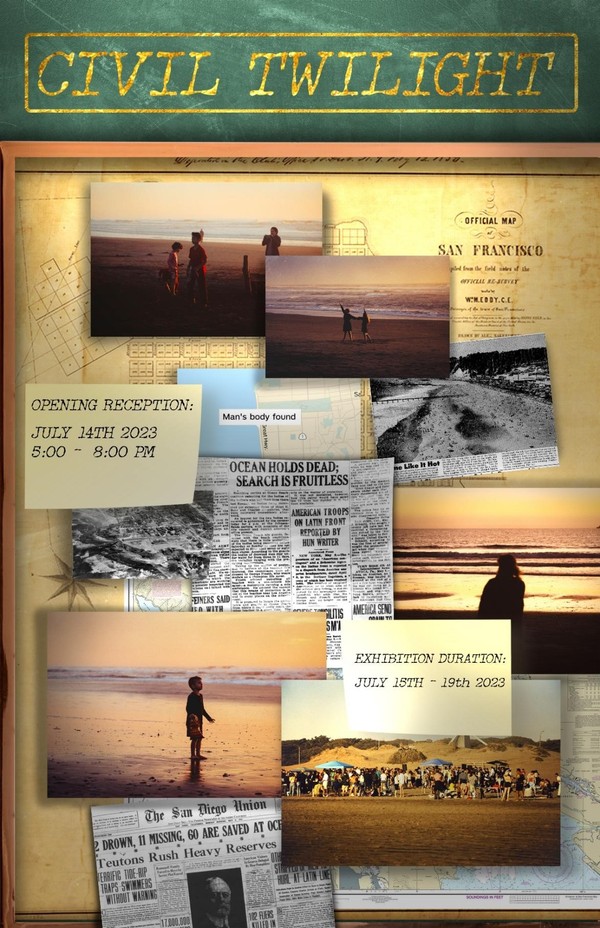
展览海报
摄影是一种追魂的艺术,一种薄暮时分的艺术。
——苏珊·桑塔格《论摄影》
Photography is an elegiac art, a twilight art.
- usan Sontag, "On Photography.S"
Civil twilight这一气象学术语指日落后或日出前,没有太阳却有余晖或曙光照亮的时刻。牟瀚林的摄影项目《Civil twilight》有关在这一段的晨昏交界时间在旧金山大洋海滩(Ocean Beach)附近消失的人。他的摄影图像为我们展现了自然美景背后的危险和哀思,同样也提醒我们对大自然的敬畏。
Civil twilight is a meteorological term that refers to the time after sunset or before sunrise when there is no sun but there is an afterglow or twilight. Hanlin Mu's photographic project Civil twilight concerns the people who have disappeared near Ocean Beach, San Francisco during this time of day. His photographic images reveal the dangers and sorrows behind the natural beauty and remind us of our reverence for nature.

展览现场
摄影师以旁观者的角度,用报纸、互联网等新闻渠道,重构当地新闻中出现的海边消失人口案件,对于这些受害者生前不久的场景进行猜测和重现,绝大多数都拍摄于civil twilight这一时段内。在他的镜头下,橙黄、金色、粉紫色在天空中交相辉映,倒映在看似宁静的大海上。人们在海滩上驻留、奔跑、嬉戏、玩耍,在海浪的泡沫中行走,或是相互交谈。
From the perspective of a bystander, the photographer uses newspapers, the Internet and other news channels to reconstruct the cases of people disappearing from the beach in the local news, and to speculate and recreate the scenes shortly before the victims’ deaths. Most of these images were taken during the civil twilight period. Under his lens, oranges, yellows, golds, and pinks and purples are reflected in the sky and on the seemingly serene sea. People linger, run, play, walk in the foam of the waves, or have conversations on the beach.
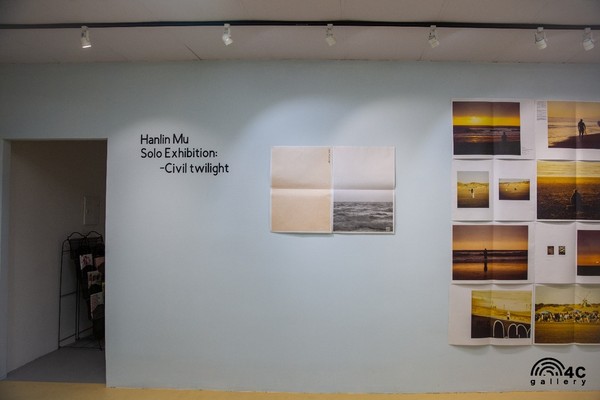
牟瀚林的镜头里不仅仅是海滩落日,更是传达这些图像背后的悲剧内核——在极具诗意的画面中,寄托了无限的哀伤。夕阳是一天光阴的弥留时刻。在漫天的余晖中,人们常常在黑暗来临前感受到对于光明和过去的追思。在观赏这一组摄影作品时,我们被提醒着:这有关一些人生命的最后时刻,美丽的风景常常也是危险的、不可触碰的。
Hanlin Mu's camera is not only about sunsets on the beach, but also conveys the tragedies behind the scenery and infinite sadness in a very poetic tone. Sunset is the final moments of the daylight. In the afterglow of the sky, people often feel the remembrance of the light and their past before the darkness falls. In viewing this collection of photographs, we are reminded that they are about the final moments of people's lives, and that beautiful landscapes are often dangerous and untouchable.
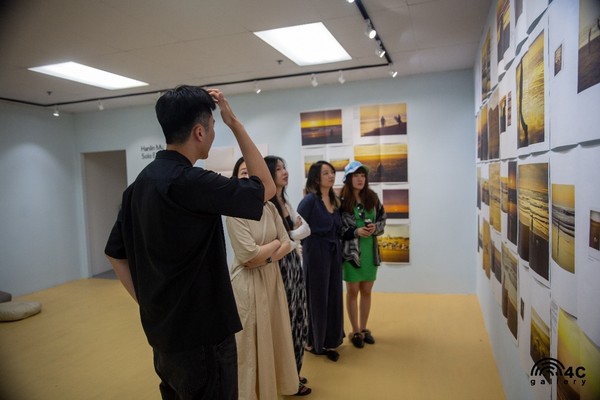
展览现场
使用摄影媒介进行艺术实践本身便是无常的最好证明。摄影媒介的本质便在于人或物的脆弱性、可变性、必死性,在于冻结时间流里的这一刻并见证其流逝。我们拍下的照片,常常带着我们穿越到那个原本回不去的瞬间。我们如此追忆已经离开的同伴:摄影图像代替了被拍摄者的在场性,又恰恰证明了其本身的不在场。牟瀚林的摄影作品通过对受害者弥留时刻的再现,与死亡的主题直接相关,与摄影本身呈现的“不在场”和瞬间性的性质不谋而合。在这个系列中,艺术家大量使用了人物剪影,并且弱化人物面部细节,进而传递出故事的破碎感与不完整性。该系列共分为三种人群——“One Woman(一个女人)”、“Two Children(两个孩子)”、“The Victim(受害者)”。将匿名的身份性图像变成了一种索引,指向了在海滩上消失的不计其数的人。
The very medium of photography is the best proof of impermanence. The essence of the medium lies in the fragility, the changeability, the certainty of death of a person or an object, in freezing the moment in the flow of time and witnessing its passing. The photographs we have taken often take us back to a moment in time to which we can never return. This is how we remember our companions who have left us: the photographic image replaces the presence of the photographed as a substitute, which precisely proves the absence of the photographed. Hanlin Mu's images are a reproduction of the victims’ last moments, which is directly related to the theme of death and coincides with the nature of photography itself as a display of "absence" and immediacy. In the series, he makes extensive use of silhouettes, or makes the faces of the people not clearly visible, to convey the sense of fragmentation and incompleteness of the story. He divides the series into three groups of people - "One Woman", "Two Children", "The Victim". In anonymity the identity-based image becomes an index, pointing to the uncounted number of people who disappeared on the beach.
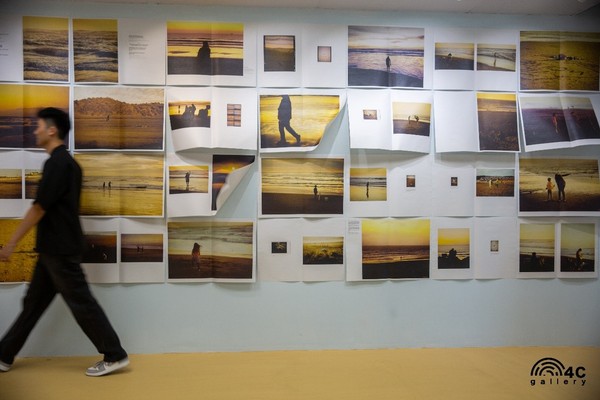
在《Civil Twilight》中,牟瀚林根据真实事件虚构场景的手法使人联想到电影。它们模糊了虚构和现实的界限——根据真实案件,创造虚拟的“真实”摄影图像。在观看时,这些“弥留之际的照片”可信度是极高的:嬉戏的孩童们尽情地玩耍、舞蹈;冲浪者望向未知的海面走去;海滩上的人群熙熙攘攘,狗追逐着乌鸦……此刻,摄影媒介的“记录性”与其本质的想象场景产生了微妙的化学反应。
In Civil twilight, Hanlin Mu's technique of fictionalizing scenes based on real events is reminiscent of filmmaking. This work blurs the line between fiction and reality - creating virtual "real" photographic images based on real cases. When viewed, these "photographs of the final moments" are highly believable: children playing and dancing, surfers looking out into the unknown water, crowds on the beach, dogs chasing crows…… At this moment, the "documentary" nature of the photographic medium creates a subtle chemical reaction with its imagined essence.
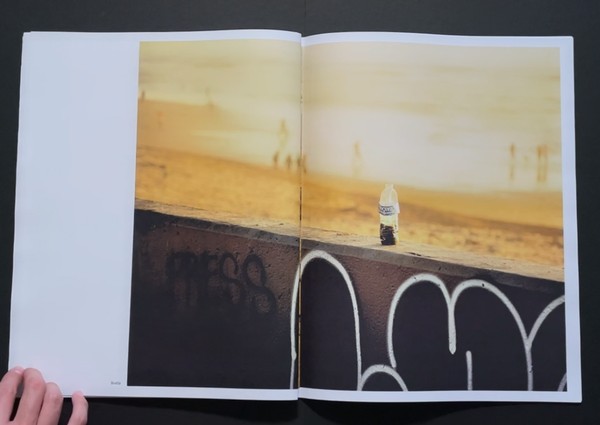
汉斯·贝尔廷在《图像人类学》中提到,辛迪·舍曼的摄影系列《Untitled Film Stills》通过一系列刻板化的女性荧幕形象让观众混淆其作品的媒介,误以为摄影作品是五六十年代好莱坞电影的静帧。作为一个虚构叙事,《Civil twilight》的可信度是极高的,除了对于人物在自然状态下的抓拍,也有环境空镜和对于他们“遗物”的写照——孩子们的玩具、装了沙的矿泉水瓶、海滩上的躺椅……同时,这些图像由不同的摄影媒介拍摄——数码相机、拍立得、胶片,戏仿各式各样的新闻照片和影像信息收集渠道的多样性,展现出清晰度和质量不一的特点。
In Anthropology of Images, Hans Belting refers to Cindy Sherman's photographic series Untitled Film Stills as a series of stereotypical on-screen images of women that confuse the viewer with the medium of the work, as the viewer mistakes the photographs for stills from Hollywood films of the 50s and 60s. As a fictional narrative, Civil twilight is highly believable, with shots of the characters in their natural state, but also environmental aerials and portrayal of their "remains": children's toys, sand-filled mineral water bottles filled with sand, lounge chairs on the beach, etc. At the same time, these images are taken with different photographic media - digital cameras, Polaroid, film - parodying the variety of news photographs and the diversity of channels for collecting information about the images and displaying varying degrees of clarity and quality. The series of photographs gives the false impression that this is a collection of news photo.
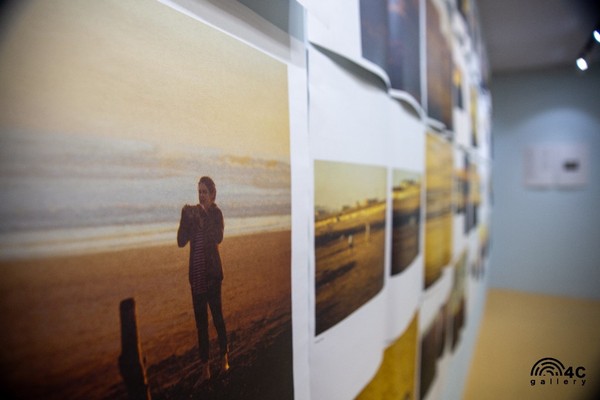
在《Civil Twilight》中,照片让人误以为这组摄影作品是新闻照片,或者一部记录性短片的静帧。摄影系列原本呈现于报纸印刷的摄影集,报纸这一媒介体现出短暂的时效性,同样也是对于新闻照片媒介的戏仿。失踪者的报道只会出现在当天的报纸版面,像时间的节点昙花一现,只有图像才证明他们曾经的存在,但这样的曾经存在却又是不容置疑地不可挽回。
In Civil Twilight, the series of photographs leads one to believe that the photographs are news photographs, or still frames from a short documentary film. The series was originally printed in newspapers, a medium that embodies the ephemeral nature of time, and likewise parodies the medium of the news photograph. Reports of the missing only appear in the pages of that day's newspaper, a fleeting moment in time, and only the image proves that they once existed, but that the once existed is undeniably irrevocable.
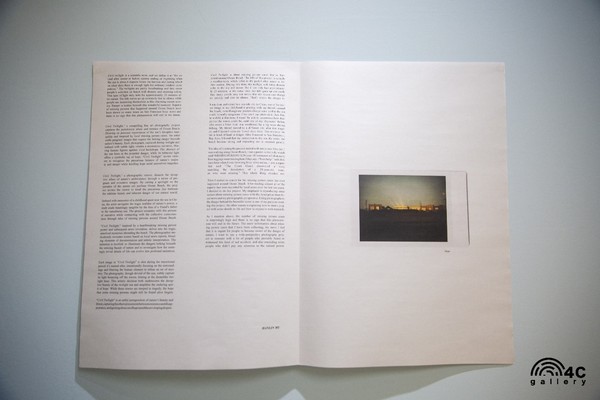
所有的这些特点使得牟瀚林的创造性摄影与新闻摄影的真实性产生暧昧的关系。在与真实性的舞蹈中,图像变得更为破碎、转瞬即逝。但在《Civil twilight》的最后一张照片中,海滩边的房子反射出三道太阳的光芒,在被黑暗笼罩的海滩中格外显眼。海浪见证着每天的变幻,海是无情的。黑暗降临之后,人类仍然在守望同类的亡魂。还会有谁的影子再度洄游到此处吗?
All these characteristics construct an ambiguous relationship between Hanlin Mu's creative photography, photojournalism and authenticity. In the dance with authenticity, the images become more fragmented and fleeting. Nonetheless, in the final photograph of Civil twilight, the beach-side house reflects three rays of the sun, standing out against the darkness that envelops the beach. The waves bear witness to the daily changes; the sea is relentless. After darkness falls, humans still watch for the dead. Will any of their shadows migrate back to here again?
文:黎扬扬

分享到微信,
请点击右上角。
再选择[发送朋友]
或[分享到朋友圈]

